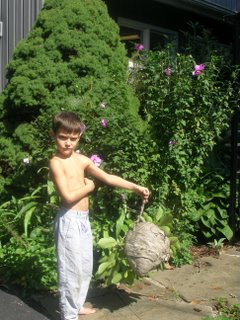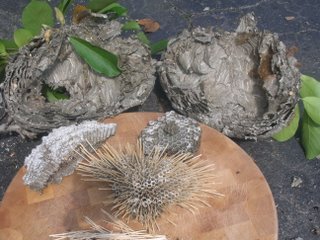Hornet's Nest
We kicked off the school year by removing a large bald-faced hornet's nest that had terrorized the driveway all summer, forcing residents and guests alike to seek alternative ingress and egress. I recall a couple of incidents in particular that were less like egress and more like haulin' butt.
Testing the nest was necessary before we could attempt to remove it. Kyle suggested whacking it with a big stick, kind of like a pinata. Josh preferred a water hose at full blast. These two test methods assumed, of course, that the tester would be myself. I chose a less intrusive method - climbing a ladder, I shook the branch lightly back and forth. When no activity ensued (save for a curious yellow jacket that scared the crap out of me), I took my snips and deftly cut it down. Josh stepped up to accept the trophy, and here he holds it like a man who is not the least bit intimidated by his prey. Actually, it wasn't so much the nest that scared him, it was those darn hornets.
You can see that the nest is as big as his torso. Being home alone at the time, we procured some scientific instruments from the kitchen:
- Cutting Board
- Serrated Bread Knife
- Toothpicks
Field Note - when using expensive items from the kitchen, never leave them in the driveway for spouse's return.
Anyway, we cut the nest in two, revealing quite a complex structure. At the core are the honeycombs that house the queen's eggs. There were several layers of perfectly hexagonal cells, each built in succession under the previous layer, attached as a sort of pod. 
Surrounding this amazing high-rise nursery are the paper walls. These are constructed from, well... hornet spit. They chew wood and mix it with saliva and spit the solution out to create a lightweight (but strong) paper-like substance. 
The walls are 9-10 layers deep. A small hole near the bottom permits entry and exit, while allowing them to guard the nest. This nest had a large hole in the back, presumably created by a predator as the hornet colony waned and the hornets died off.
The queen begins the colony by building a honeycomb, depositing her eggs (not sure where they come from - ask your parents) and sealing them in. They hatch into larvae, mature and break out of the cell to become slaves of the colony. You simply can't find good help these days, unless you grow your own - ask Josh and Kyle about this.
As the colony grows, the structure grows. Workers actually eat the inner walls and redeposit them on the outside of the structure - kind of like reframing a house to make it bigger. Except, its a lot grosser.
As the summer nears its end, the queen begins to lay the eggs of fertile males and females. For extra credit, can you guess which of these is expendable? Hint: the males die off. The females fly off as the colony nears its end, and "hibernate" for the winter. In the spring, they will start new colonies.
We made a project of counting the hexagonal cells. Man, the boys were PSYCHED! Counting egg cells - woo hoo! Anyway, we devised a method to keep track of our counting by inserting toothpicks into the counted cells. 
Josh and Kyle lost interest at about 13. I kept at it though, and eventually counted 896 cells. Hey, what else do I have to do? Anyway, that's a lot of babies! Just think of all the nighttime feedings - tired parents pacing, burping, changing diapers. I'm exhausted just thinking about it.
This one section of honeycomb contained 452 cells. When I'd finished, it looked more like a porcupine than a hornet's nest!
You can find some good information on bald-faced hornets at http://www.vespa-crabro.de/baldfaced-hornet/baldfaced.html.
1 comments:
Jim,
You never cease to amaze me. You are providing your kids not only a warm and healthy environment to grow in, but you are exposing them to all kinds of learning experiences. You have my vote for father and teacher of the year.
Gustavo.
Oh, yeah. You will also get "the man with a bucket of mud" award for best handyman.
Post a Comment